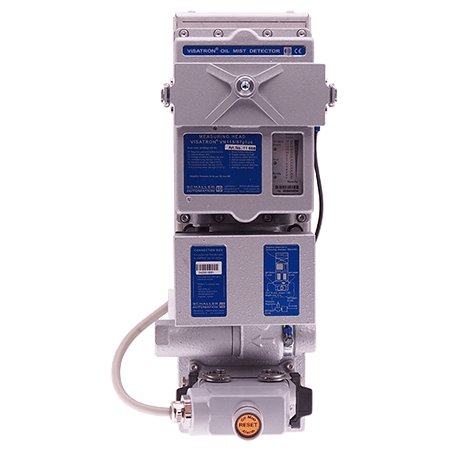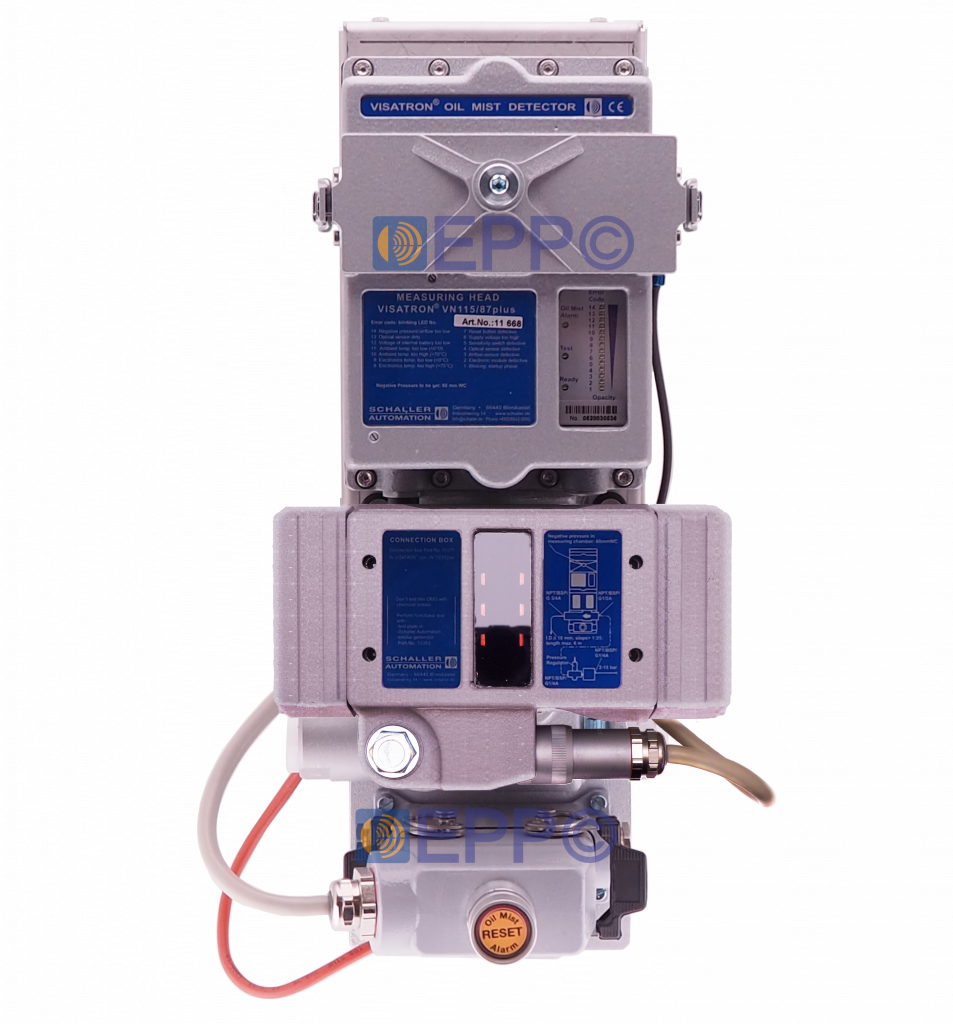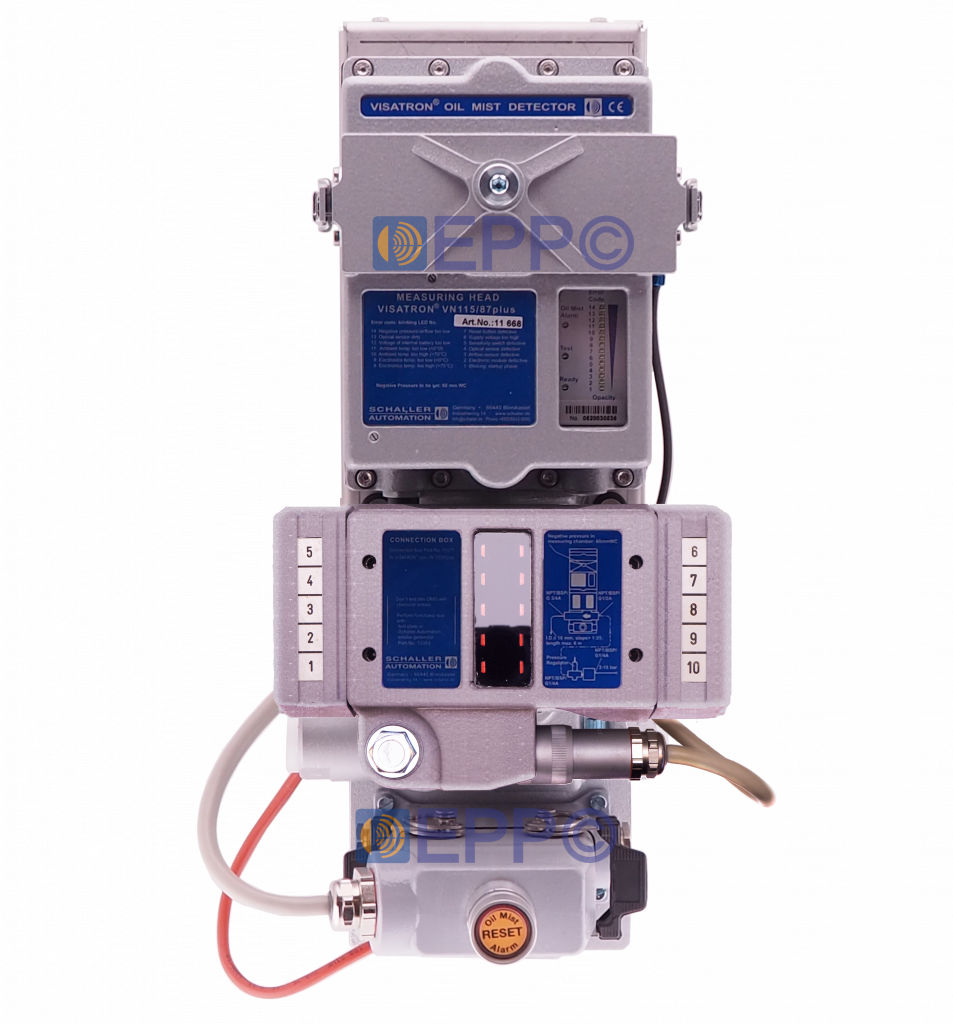Visatron VN/87plus
The VN/87plus generation consist of: VN 115/87plus, VN 116/87plus & VN 215/87plus. The VN87plus is the successor of the VN/87 EMC. The VN/87plus was placed into the market in 2008 and was in production until the system was replaced by the VN2020 and VN301plus in 2020. The VN/87plus was mainly used for 4-stroke engine market, and the system requires a single tube installation. The VN 116/87plus and VN 215/87plus was mainly used for the 2-stroke engine market. The VN 215/87plus indicates during a high oil mist concentration alarm which compartment the oil mist is coming from. The VN 116/87plus indicates from what side (right or left side of the OMD installation), the oil mist concentration is coming from. The VN 115/87plus is during a high oil mist concentration alarm, indicates that there is coming oil mist concentration from the engine, without any compartment location of the oil mist.
For the VN/87plus version we supply:
- Authorized repair of the complete VN/87plus line
- Exchange Pool for all VN/87plus models
- All types of spare parts delivered within 24 hours!
- Sale of reconditioned units of the VN/87plus line
- Technical 24/7 service supply
- Authorized service on-site
- Service agreement
VISATRON VN 115 series continuously and simultaneously evaluate crankcase atmosphere from each crankcase compartment between two main bearings.
The VN 115 and VN 116 series use a header-suction-tube system for this purpose. The oil mist detector is positioned in the middle between two header-suction-tube sections located on the engine sides; from these sections, single-suction tubes branch off near the compartments. These tubes are considerably thinner than the header-suction tubes and they have a throttling effect. Owing to the large header-suction- tube diameter the vacuum and consequently the sample flow at each suction point remain virtually constant. The arrangement of the detector in the middle of the header-suction tube results in an optimally short sample running time in the tube system.

In the detector itself the sample mixture of both header-suction-tube sections is conducted through an optical turbid metric channel. Subsequently, the oil mist is discharged together with the exhaust air from the wear-resistant air jet pump.
The turbidity of the crankcase atmosphere (oil mist droplets having a diameter of approx. 5 mm) is measured by optical absorption. The measuring path consists of two infrared diodes, one of them working as a transmitter and the other one as a receiver. Oil mist passing between them absorbs some of the infrared light, thereby reducing the amount of light reaching the receiver. The selected unit of measurement is % opacity [%OP]; 0% opacity means zero, turbidity, 100% OP, however, total optical absorption.
VISATRON VN 116 series as compared to the VN 115 series, is more sensitive because it has an additional differential alarm level.
It compares the oil mist concentration from each side of the heeder-suction- tube section and responds if there is a difference, this being a sure sign for an overheating damage in the compartment group with the higher opacity.
The differential alarm level is carried along with regard to its sensitivity relating to the 10-stage adjustment of the alarm level which is also available for VN 115. For measuring the opacity differential, the sample flows of both header-suction-tube sections are fed to the turbid metric channel one after the other by closing the respective tube sections alternately by means of reed valves.

The microprocessor saves both opacity values and executes the opacity comparison (damage check). In home position both valves are open. They only become operative if the compound opacity from both header-suction-tube sections exceeds the sensitive threshold for starting the damage check. This will trip an alarm if the decisive differential alarm level is being exceeded. At the same time it is indicated in which compartment group the damage has occurred.
Oil mist is explosive from a concentration of 50 mg of atomized oil in 1 liter of air = 40% OP, ignition temperature of approx. 500 C. It is important that the opacity value exponentially depends, upon the oil mist concentration, i. e. it is already very high in case of a minor turbidity. Therefore, turbidity measurement with the header-suction-tube system can also reach a high sensitivity (e.g. 0,5% OP= 0,1 mg/l of oil mist) from a damaged compartment mixed with crankcase atmosphere from the other compartments is diluted in the header-suction tube. In case of medium speed trunk-piston engines the compartment volumes are relatively small compared with the crankcase of crosshead engines so that the oil mist has developed from an overheating damage will rapidly result in a higher concentration.
VISATRON VN215/87plus, operates in the same way as the VN 116/87plus as far as the tripping of an alarm is concerned.
However, it is able to additionally indicate the suction point with the highest opacity and thus the compartment in which the overheating damage has occurred.
Unlike the other types, the VN 215 series has a single-suction-tube system, each compartment being connected by a separate tube to valve box designed for 10 suction lines. All procedures are similar to those of type VN 116 series.
Normally, the compound opacity of the oil mist from all compartments will continuously be measured. If the opacity exceeds the damage check starting threshold a damage check will be executed. lf the differential alarm level is exceeded, an alarm causing the automatic stop of the machine or a speed reduction will immediately be tripped.

In contrast to the type VN 116 series, a search run will be continued. By closing the valves of certain compartment groups according to an iteration procedure and by an opacity comparison, the single-suction line can finally be determined which is supplied with oil mist from the compartment in which the overheating damage has occurred. For damage indication on the detector, the position of the valve which is still left open is used for indicating the damaged compartment.
In order to meet the high mechanical and electrical demands and to take account of the mostly limited space at the engine, all VISATRON oil mist detectors are constructed as packaged units by using aluminium cast, with the wear-resistant air jet jump, the vibration-isolated base plate for the metal-clad measuring unit with plug and socket connection as well as the electrical and pneumatically connections being erected on a solid cast iron plate. The suction tubes on the left and right side are connected to the valve box by two molded rubber flanges having no threads. The use of the particularly advantageous siphon assembly likewise allows a connection of the tubes of the siphon blocks without any threads.
All subassemblies including the valve box are provided with plug and socket connections and can, if necessary, be exchanged without the tubes at the engine having to be dismounted.

